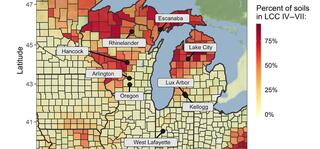Land-use model shows planting switchgrass can increase soil carbon on non-agricultural land

The bioenergy crop sequesters more carbon under lower emission climate scenarios.
The Science
Switchgrass (Panicum virgatum) can store carbon in soils not typically farmed for annual food crops, or marginal lands, according to a modeling study from the Great Lakes Bioenergy Research Center (GLBRC). The model simulated 20 years of switchgrass growth under three climate scenarios with atmospheric CO2 levels of 450 ppm (sustainability), 590 ppm (middle-of-the-road), and 950 ppm (high). Switchgrass added carbon to the soil under each scenario, but higher CO2 emissions led to lower storage estimates as greater warming caused more carbon to be respired back into the air. The findings suggest that the perennial bioenergy crop could help mitigate carbon emissions, but this ability decreases with climate change. This trend could be mitigated by adapting switchgrass varieties.
The Impact
The study is the first to quantify how climate change may affect switchgrass carbon storage on marginal lands. The model’s average estimate of 0.87 Mg C ha-1 year-1 stored more than triples the estimated 0.25 Mg C ha-1 year-1 emitted by growing switchgrass and converting it to biofuels. This result suggests that switchgrass-derived biofuels can lead to a net decrease in carbon emissions. However, the size of this carbon benefit will be affected by climate parameters as well as plant biomass production and soil characteristics.
Summary
Switchgrass is attractive as a potential bioenergy crop because it can grow for years without having to be replanted and requires less fertilizer than typical annual crops such as corn. The plant’s deep root systems and plentiful aboveground biomass can also remove carbon from the air and add it to the soil, potentially mitigating carbon emissions. GLBRC researchers modeled carbon storage associated with switchgrass plantings in Midwestern experimental sites with varied soil composition under three climate change scenarios.
In 20 years of simulated growth, switchgrass added an average of 0.87 Mg C ha-1 year-1 to the soil, with ranges of 0.2-1.3 Mg C ha-1 year-1 depending on the climate and soil composition. More than 89% of the variation between the scenarios was attributed to either climate variables, such as latitude, daily temperatures, and precipitation (52.8%), or soil composition (36.4%).
The “high emissions” climate change scenario resulted in the lowest average carbon storage in the ground, with likely outcomes closer to carbon neutral (0.25 Mg C ha-1 year-1). This is likely due to less plant growth and higher levels of soil respiration. Planting switchgrass varieties with longer growing seasons that thus produce more root biomass mitigated more than 60% of carbon losses in the soil due to climate change in this scenario. Importantly, sites with large initial amounts of carbon in the soil reached a carbon saturation point within the model’s twenty-year time frame, indicating an upper limit to how much carbon switchgrass can sequester in the soil.
Program Manager
N. Kent Peters
kent.peters@science.doe.gov, 301-903-5549
Corresponding Authors
Rafael Martinez-Feria
mart2225@msu.edu, 517-884-4939
Bruno Basso
MSU Foundation Professor, Michigan State University
basso@msu.edu, 517-353-9009
Funding
This research was supported in part by the US Department of Agriculture National Institute of Food and Agriculture (awards: 2018-67003-27406, 2019-67012-29595), the US Department of Energy, Office of Science, Office of Biological and Environmental Research (awards DESC0018409 and DE-FC02-07ER64494), and Michigan State University AgBioResearch.
Publications
Martinez-Feria, R. and Basso, B., “Predicting soil carbon changes in switchgrass grown on marginal lands under climate change and adaptation strategies,” GCB Bioenergy 12, 742-755 (2020). [DOI: 10.1111/gcbb.12726]
Related Links
https://onlinelibrary.wiley.com/doi/abs/10.1111/gcbb.12726